Watches that have a connection to space missions are always popular with collectors, the most obvious being Omegas Speedmaster which back in the 1960’s came first in trials to become the official watch used for space flight by NASA. Seikos 6139-6002 also has a part to play in the space mission story as commander William R Pogue wore his example during his eighty-four day Skylab mission between November 16 1973 and February 8 1974. Although he was not officially sanctioned to do so, Pogue wore the watch during his duration on Skylab. He travelled around the Earth 1214 times for a total of thirty-four million miles with the watch on his wrist. He also used the watch during pre-flight training to time the engine burns. Seikos 6139-600x chronograph has now become better known as the “Pogue” for the above reason.
Another interesting fact about the 6139 is it was one of the first automatic chronographs to be developed, in fact there’s an argument that it was actually the first available to the general public. The race to produce the first automatic chronograph was coming to fruition at the end of the sixties and the two main contenders were the Zenith-Movado group and a joint effort from Breitling, Hamilton/Bren, Heuer/Leonidas and Dubois-Depraz. These watchmaking houses joined forces because it was felt that a single house wouldn’t be able to complete the job on the grounds of insufficient technology, manpower and budget. By 1969 the work was done and the Breitling group announced their caliber 11 on March 3, and Zenith announced their El Primero around September of that year. The thing was that Seiko quietly released their 6139 calibre chronograph at the beginning of 1969 with a distinct lack of fanfare, however there are examples of this watch in existence with a caseback date of February 1969 which seems to suggest they were the first to the market with their offering.
The example featured is a 6139-6002 from 1977 which unusually is still owned by the original purchaser. The crown had been caught and snapped off and once this happened the watch was put in a drawer and there it lay for many years.
This has meant the watch has survived in very good condition indeed with very little wear to the case and the dial, hands, indicator ring and bezel insert are all excellent. The work required was a full movement service, a new stem and crown, a deep clean of the case and pushers, new seals and a new crystal. The pushers below are reasonably clean believe it or not, I’ve had to remove sets with a pin vice in the past because of accumulated grime!
With the movement removed you can see how good the dial and handset is, it unusual to see them this good in a watch that’s approaching 40 years old.
A big potential problem with the 6139 (and 6138) is if the centre wheel vertical clutch is worn. This is the component that engages and disengages the power from the drive train to the chronograph hands and can be seen in the centre of the movement. Once these are worn there’s very little that can be done in the way of a permanent fix to bring them back to life. It means the hand slips when the chrono is running and it also will start resetting to random positions. The proper fix is to fit a replacement, if you can source one! Luckily there was no problem with this one.
The watch was fully stripped ready for cleaning and inspection. There are more components in a chronograph than there are in an ordinary watch due to the extra layer of levers, hammers and column wheel.
As the cleaning was being done I turned my attention to the case. The first thing was to get it stripped and remove that scratched crystal.
These are the parts that make up the case, the yellow rotating ring is driven by a gear on the winding stem and sits in a recess below the crystals gasket supporting ring.
A new old stock crystal was sourced.
The new seals were fitted to the cleaned pushers.
At first glance the old seals look fine, it’s only when you try to remove them it becomes apparent how dry and brittle they’ve become.
A new crown and stem was sourced, this is more difficult than it sounds with regards to the stem. the stem has a little gear that fits on which turns the inner rotating indicator ring. When a crown gets broken off usually the spring and gear fly out and are lost. This means that stems and gears are always being sought and stocks of originals dried up years ago. Luckily the gear and spring were still present on this watch but it still left the problem of sourcing a stem.
There is another Seiko model that uses a similar stem (in fact the part numbers are only one digit apart), and these do turn up from time to time. The difference between the two watches is in the diameter of the case which means the gear is held in a slightly different position (farther out) on the replacement stem. As you can see this is achieved with the longer bar section in between the two flat sections, this acts as a stop for the gear. To convert one of these you have to turn down the bar section slightly to allow the gear to move further down the stem, if you don’t it means when you rotate the crown it won’t turn the indicator ring unless you push the crown in to the date change position which is obviously no good.
Once the metal is removed and the stem is rebuilt it looks like this, the new crown comes with a new seal of course.
The new crystal was fitted but the bezel that holds it in place can’t be fitted until the movement is replaced as it has to be aligned with the twelve, so the next job is component inspection and movement reassembly.
The mainspring is now refitted into the barrel and lubricated. This is an automatic movement which means the watch is always being wound due to the natural movement of the wearer. Because of this the spring has to slip on the barrel wall otherwise it would break when it got overwound. Whilst the springs are designed to slip you don’t want them to slipping too much so the barrel wall is coated in a special braking grease. This allows the spring to slip whilst providing enough friction to maintain a decent power reserve.
Here’s a view of the centre wheel with its different components. The top section with the little dog leg is the part that turns the minute register. The whole wheel rotates once a minute and the dog leg engages with the minute wheel train once every revolution, moving it on a single increment each time. Directly below this is the reset heart, when the hands are reset to zero and the pusher is depressed, coupling levers cause the hammer to act on this to turn the wheel back to the rest position. The next component is the clutch, the disc assembly above the actual geared wheel. When the chronograph is at rest two levers are brought towards each other from either side of the clutch. They both have a little tab that gets forced in between the faces of the plates and separated the drive plate from the driven plate disconnecting the drive. When the chronograph is started the levers are moved apart, the tabs are withdrawn and the two plates are pressed together with a spring which connects the drive and the hand starts to rotate. Simple!
Here’s a better view of a reset heart, this one is on the minute register wheel.
The going train is installed at this point, the levers, hammer and column wheel are yet to be fitted.
It’s ready for the top chronograph plate to be fitted in this shot. You can see how the centre wheels dog leg interacts with the minute registers transmission wheel (the shiny one) as it rotates anti-clockwise. The component below the transmission wheel is the reset hammer which acts on the hearts on both the centre wheel and the minute register wheel.
Here’s a shot of the balance bridge, balance wheel and hairspring. It’s called a bridge as it’s supported from more than one position, usually balances are secured with a balance cock which is only supported from one side. This illustrates a correctly coiled and centred hairspring, vital for good timekeeping.
Here the balance is refitted and the movement’s ticking away nicely. There’s still the autowind work and bridge to be fitted yet, these are tall movements!
The calendar side is a pretty standard Seiko affair.
Note the minute register pinion poking out from between the day/date disks at the 6 o’clock position.
The dial and hands were refitted making sure the date changeover is at midnight!
And the chronograph hands were refitted and tested. The reset button needs to be kept depressed when fitting these to hold the relevant wheels in the correct position.
The movement was recased with the autowind work and rotor reinstalled….
….which allowed the bezel to be aligned and pressed home, the bezel actually holds the crystal in position. Here’s a shot with the replaced parts.
Now it’s time for a pressure test, into the chamber and up to pressure.
Wait at least 15 minutes then submerge.
Release the pressure and if there’s no stream of bubbles escaping from anywhere it’s passed. Not that I’d expect or advise anyone to go swimming with a vintage watch on their wrist, but at least now there’s some peace of mind that it should be fine when washing the car, the dishes or your hands!
And here she is, a beautiful example of the Seikos famous “Pogue”.
A couple of shot’s back on the original bracelet.
A final shot, this time of the caseback indicating a production date of May 1977.
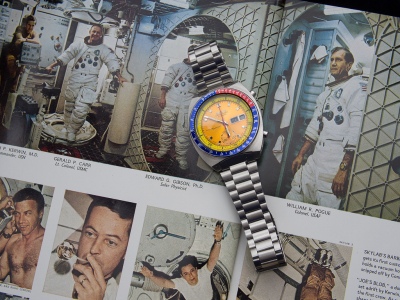
























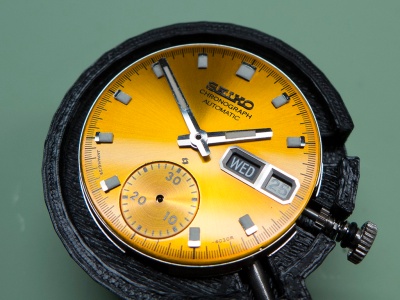

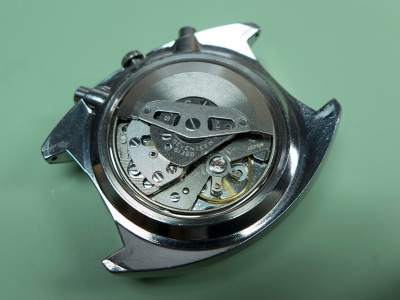
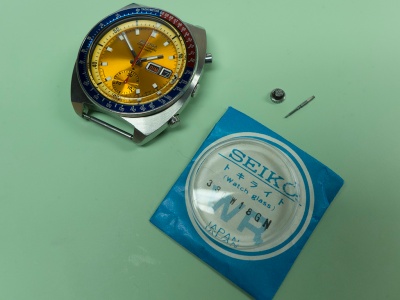





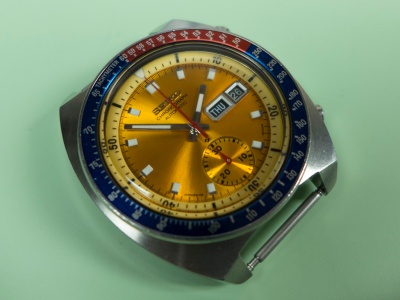
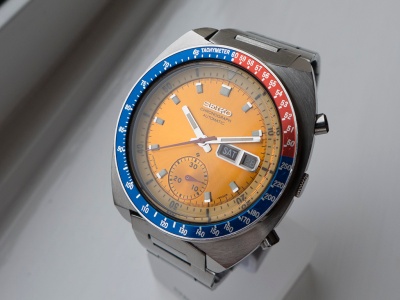

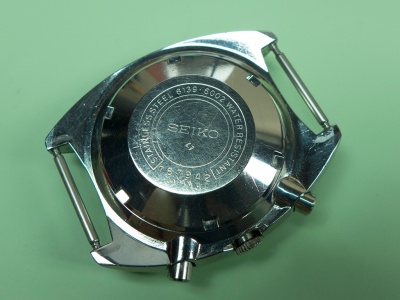
Hi,
I have a 6139-6002 which was my fathers. It appears to be in good working order except that I cannot seem to change the day date. Is this fixable?
Regards
Doug
LikeLike
Anything’s fixable but there are quite a few things that could cause date change issues. Without stripping the hands and dial I couldn’t tell what the exact problem is unfortunately.
LikeLike
nice work, a great example of a classic Seiko
LikeLike
Hi there I have owned a 6139-6002 since 1979 when I joined the army. Can you recommend where I can get it serviced? Great write up George
LikeLike
I own a 6139 since 1969. It has never been out of my possession. The watch runs fine and keeps perfect time. The second hand resets to the 8 o’clock position and the crown has separated from the stem, thus I cannot change the hour or minute hands. Who can repair this.
Any sources would be appreciated.
LikeLike
I’m sure I could sort it out for you Keith, contact me using the contact page.
LikeLike
Very useful and great description, thanks a lot! I bought this Seiko when I was working as a waiter and had only little money back in the beginning of the 70s. Unfortunately I lost the watch after two years. Now I bought one through the Internet and I am looking forward to recieve it the next days. I seems this watch turns back the time for me and brings me back to my youth…
Many greetings from Graz in Austria (not Australia) 😉
LikeLike
Hi I just found out that you were the guy that serviced my speedmaster, It is running like a dream and im really happy with my watch. Just need to gain some links for the band, any advice please on gaining links or good bands?
LikeLike
You don’t say where you are located but USA = Otto Frei and UK = Cousins.
LikeLike
Great article. I’ve a 6139B which has been in my possession from new. the pushers have recently started to stick and having taken the back off I can see why. One is bent and the other is just very dirty. The rest of the watch looks good but I dont know where I can get new pushers and new seals for these, the crown and case back. Can you suggest where I may be able to get these parts?
Cheers,
Rob
LikeLike
Ebay’s your best bet.
LikeLike
Thanks I will take a look
LikeLike
Hi I have a question, you don’t happen to have a inner bezel blue for a seiko pogue blue? I broke mine by accident and i’am looking for one to recase my watch asap?
Thanks!
Mac
LikeLike
Thoroughly enjoyed reading about your restoration. I am booked on at BHI weeks course in watch repair next year. Do you think a Seiko 6139 would be beyond a novice for a restoration such as yours? I realise there is more to a chronograph than an automatic or manual winding watch. I have a few Seiko watches including an Alpinist and my beloved SKX007 I have just modified with a new domed crystal and ceramic bezel insert. It looks stunning.
I seem to have a burning desire to own a 6139 Col Page but could not really justify the cost of a good one.
Thanks again for your great story.
Chris
LikeLike
They’re a bit more complicated for sure but if you’re methodical I don’t see why it shouldn’t be beyond your capabilities. However if all you’ve done so far is fit a new crystal and insert then I think you’d be better off getting a professional to do it!
LikeLike
My Seiko 6139 – 7109 was bought by myself in Antigua WI on September 1977. Its been serviced twice, once with a new crystal. That was here in Cape Town. At least twenty years back It would run say four days then stop, I would leave it for many months then the same again, the push buttons no longer work, the Crown only on the date , otherwise it was keeping good time. Would a service and clean fix the issue?
LikeLike